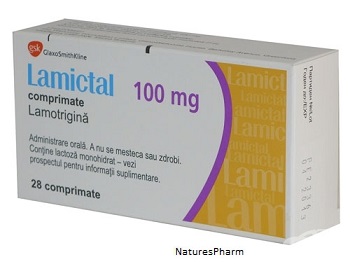What is Lamictal?
Lamictal(Lamotrigine) is designed to treat partial seizures in patients over 16 years of age while converting from the valproate (anti-epileptic medicine). This treatment is also used to heal certain types of seizures in combination with other medications.
Lamictal is a medicine, helpful in treating seizures, and chemically non-related to other anti-seizure preparations. The exact working mechanism is unknown.
As discussed, this prescription drug is used to control seizures associated with epilepsy, especially partial or the Lennox-Gastuat Syndrome. This generic drug is used alone and also in combination with other medications to treat convulsions in adults and children above two years. This generic drug is also used individually for treating partial seizures in patients above 16 years when converting from the anti-epileptic drug valproate. In addition, the medication is recommended to delay mood episodes in adults with bipolar disorder.
Usage of Lamictal (Lamotrigine) has not only reported to have resulted in life threatening rashes, but this generic drug is also not safe for children and, hence, it has not been approved for their use. In adults, the rashes are rare, but the risk increases when the dosage of the prescription drug is raised faster than recommended or if the generic drug is being taken in combination with valproic acid. Lamictal (Lamotrigine) has also reported to have caused severe liver damages in some patients. The most common side effects of this generic drug include headache, nausea, vomiting, rash, double vision, blurred vision, dizziness, fever, sore throat, peeling, chest pain, pale skin, easy bruising or bleeding, muscle pain, tenderness, or weakness with fever or flu symptoms and dark colored urine. In addition, like most anti-epileptic generic drugs, usage of Lamictal (Lamotrigine) may also give rise to suicidal thoughts and behavior.
Lamictal Information
In case patients take Lamotrigine simultaneously with valproic acid (Depakote), the initial dose of Lamictal should make 25 mg every other day during two weeks, then 25 mg per day for two weeks. The dosage has to be increased gradually (by 25 to 50 mg per day) every one to two weeks until it makes 100 to 150 mg per day. Average doses of Lamotrigine should be taken twice per day.
In case patients take Lamotrigine without valproic acid (Depakote), the initial dose of Lamictal should make 50 mg per day during two weeks. Then it should be exceeded to 100 mg per day, which should be divided in two doses and taken during 2 following weeks. Afterwards the average dose is 300 to 500 mg per day, taken in two divided doses.
Lamictal Safety Information
The starting dosage of Lamictal (Lamotrigine) for patients who are not taking Depakote (valproic acid) is 50 mg taken once every day for two consecutive weeks. After two weeks the daily dosage of this generic drug is increased to 100 mg taken twice in measures of 50 mg each. From then on, the typical daily or maintenance dose of this generic drug is between 300 mg and 500 mg taken twice in equal measures depending on the patient’s condition and response to the therapy with this prescription drug. However, the daily initial dosage of Lamictal (Lamotrigine) for patients taking valproic acid is 25 mg every alternate day for two weeks and then it is increased gradually by 25 mg per day every one to two weeks till it reaches the maximum dosage of 100 mg to 150 mg daily. This prescription drug can be taken with or without food, but it is essential to swallow the Lamictal (Lamotrigine) as a whole with a full glass of water. Alternately, the tablet may also be put into a teaspoon of water or diluted fruit juice and taken after it disperses in the liquid. In case of missing a dose of Lamotrigine, take it as soon as you remember to do so. However, if it's about time to take your next dose, skip the missed one and follow your regular schedule. Thus take the next dose when it's time for it. Never take a double dose at once. Try not to miss doses.
Keep Lamotrigine safe from heat, moisture, and light. Store this product at room temperature77 degrees F (25 degrees C). Short-term storage between 59 and 86 degrees F (15 and 30 degrees C) is possible. Keep this product out of the reach of children. Keep safe from pets.
Consult with your health care provider as soon as possible in case of pregnancy. The risks and benefits should be closely discussed. Lamotrigine is excreted into breast milk. Do not breast-feed while going thru the therapy.
Lamictal Side Effects
Before you start using it, it is essential to tell your doctor regarding your medical history, including heart problems, liver problems, kidney problems, and allergies. Patients using this generic drug may use sunscreen and/or protective clothing to protect against possible severe rash set in by sunlight. In addition, be careful while operating machinery or engaging in activities requiring alertness as this prescription drug causes dizziness. Also limit alcohol intake while taking this generic drug. This medication should only be used if it is absolutely necessary during pregnancy. Due to possible risks to nursing infants, breast-feeding while using this generic drug is not recommended.
Before using Lamictal (Lamotrigine) tell your doctor regarding the over-the-counter or prescription drugs used by you. You should especially mention if you are using other medications for seizures, such as phenytoin, carbamazepine, valproic acid, phenobarbital, primidone). Do not start or stop any medicine without doctor or pharmacist approval. If this generic drug is taken in combination with carbamazepine there may be a higher incidence of dizziness, double vision, and blurred vision in patients. Birth control pills can make this prescription drug less effective, resulting in increased seizures. Tell your doctor if you start or stop using birth control pills while you are taking this generic drug.
You may experience headache, fatigue, sleepiness, staggers, clumsiness, blurred vision, weakness during the first several days of treatment. Talk to your doctor if they do not go away.
Consult with your health care provider immediately in case of allergy (rash, painful sores in the mouth or around the eyes, swollen glands, hives, fever, swelling of the lips or tongue, severe staggers, trouble breathing, itching).
If you notice any symptoms of a rash, consult with a health care provider immediately and discontinue the usage of this preparation. The risk of a rash may be higher in case of overdosing, especially at the beginning of the therapy, or if the patient is being treated also with valproic acid. Most serious rashes have occurred within 2 to 8 weeks of the beginning of the therapy. But serious rash may also occur after 6 month of treatment.
Lamotrigine should only be used in children with partial seizures or seizures, associated with Lennox-Gastaut syndrome. Serious (sometimes even fatal) rash (e.g., Stevens-Johnson syndrome) is more likely to occur in children under 16 years of age.
If you notice any side effects, talk to your health care provider immediately.


